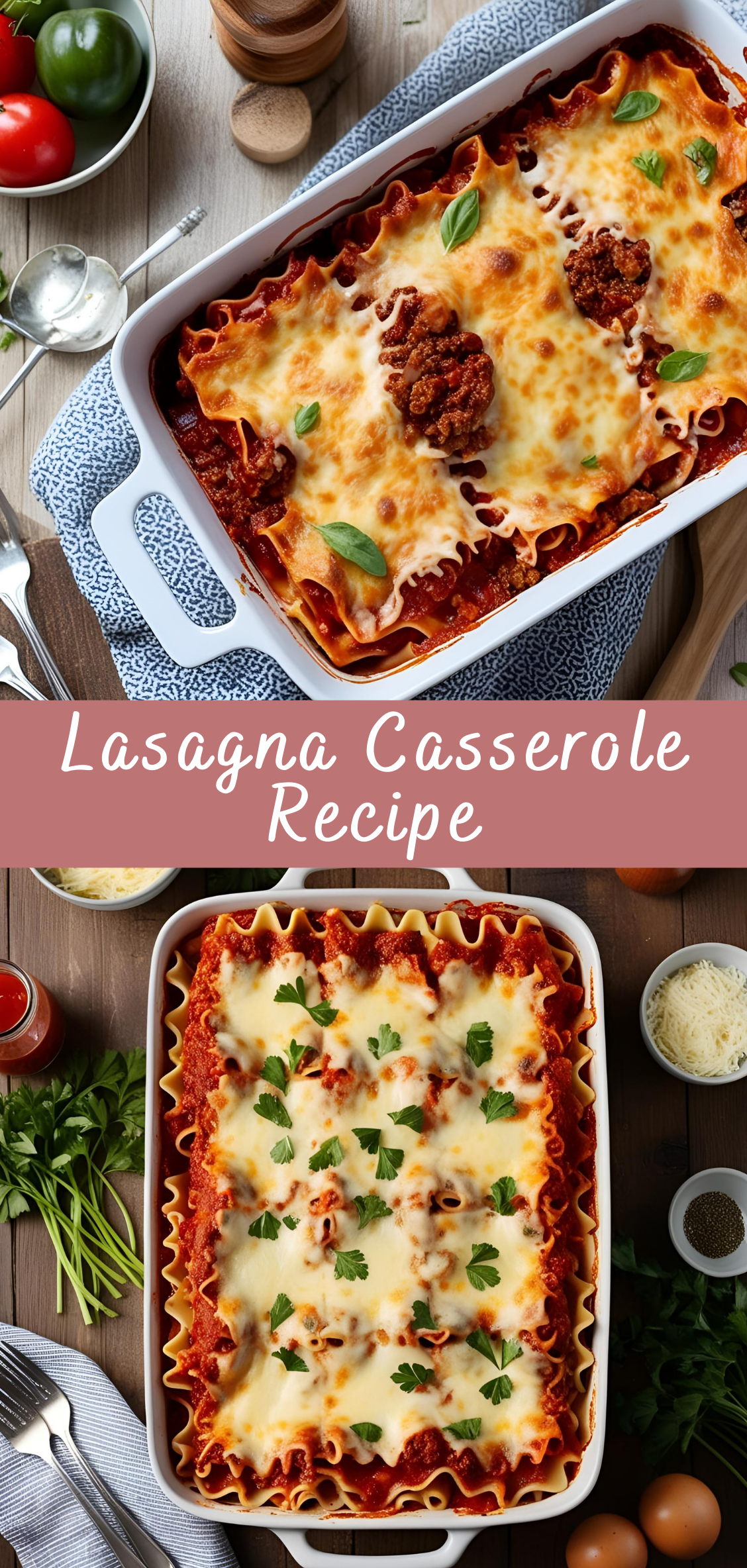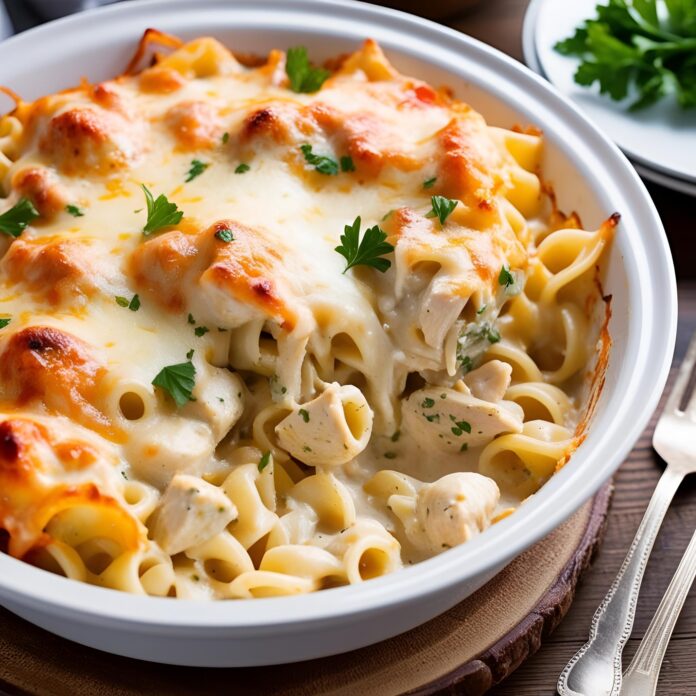Lasagna Casserole Recipe
Lasagna Casserole is a dish that combines all the heartwarming qualities of traditional lasagna with the ease and convenience of a casserole. It brings together layers of pasta, hearty meats, rich tomato sauce, and melted cheese—baked to perfection for a delicious, satisfying meal. While lasagna itself is often seen as a complex and labor-intensive dish, the casserole version simplifies the process without sacrificing the flavor or texture that makes lasagna so irresistible.

Lasagna, in its traditional form, has roots that stretch back to ancient civilizations. The name “lasagna” itself comes from the Greek word “Laganon,” which referred to a flat sheet of dough. The Romans, later, refined the dish with layers of dough, and it evolved through Italian cuisine, eventually becoming the classic pasta, meat, cheese, and sauce-filled dish we know today.
The Lasagna Casserole version, often called a “lazy lasagna” or “deconstructed lasagna,” takes the same components but eliminates the time-consuming task of layering pasta sheets one by one. Instead, pasta is mixed into the sauce, and the casserole is baked as a single dish, making it simpler to prepare and serve. It’s an ideal option for busy weeknights, family dinners, or potlucks.
What makes this dish particularly appealing is its versatility. Whether you prefer a classic meat sauce, want to go vegetarian with layers of vegetables, or love experimenting with new flavors, lasagna casserole can be adapted to suit your preferences. You can add spinach, mushrooms, ricotta, or even different types of meat, like turkey or chicken. Plus, it’s a great dish for meal prep, as it can be assembled ahead of time and then baked when ready to serve.
This comprehensive guide will provide you with everything you need to know to make the perfect Lasagna Casserole—from selecting the best ingredients, crafting the ideal sauce, and layering the casserole for maximum flavor and texture. Along the way, we’ll explore variations, substitutions, storage tips, and reheating techniques to ensure that your casserole is as delicious the second time around as it is the first.
Whether you’re new to making lasagna or a seasoned pro, this recipe will become your go-to for a hearty, comforting meal that can be easily customized to your tastes and dietary needs.
Preparation and Cooking Instructions
Creating a Lasagna Casserole is an enjoyable and straightforward process. By following these steps, you’ll have a beautiful, hearty casserole ready to serve your family and friends. This section will guide you step-by-step on how to prep the ingredients, cook them, and assemble the casserole.
Step 1: Prepare the Ingredients
Purpose: To ensure everything is ready and organized for the cooking process, it’s important to prepare all the ingredients before starting to cook. This will make the process smoother and more efficient.
Instructions:
-
Chop the Onion and Garlic:
-
Dice the onion into small pieces.
-
Mince the garlic cloves finely so they can easily infuse their flavor into the sauce.
-
-
Grate the Cheeses:
-
Shred the mozzarella and Parmesan cheeses if they aren’t pre-grated. Freshly grated cheese will melt better and add more flavor to your casserole.
-
-
Preheat the Oven:
-
Preheat your oven to 375°F (190°C) so it’s hot and ready to bake the casserole once it’s assembled.
-
Step 2: Cook the Ground Meat
Purpose: Browning the meat first helps to develop rich flavors and ensure the meat is fully cooked before mixing it with the sauce and other ingredients.
Instructions:
-
Heat a Large Skillet: Place a large skillet over medium-high heat. Add 1 tablespoon of olive oil and heat until it shimmers.
-
Cook the Ground Meat: Add the ground meat (beef, turkey, or a mix) to the skillet. Break it apart with a spoon or spatula as it cooks. Brown the meat thoroughly, stirring occasionally to ensure even cooking. This should take about 5-7 minutes. If there is excess fat after cooking, drain it.
-
Add Onion and Garlic: Once the meat is browned, add the diced onion and minced garlic to the skillet. Stir to combine, and cook for another 2-3 minutes until the onion becomes soft and translucent.
-
Season the Meat: Add 1 tablespoon of Italian seasoning to the meat mixture, along with a pinch of salt and pepper to taste. Stir to combine the seasonings evenly.
Step 3: Prepare the Tomato Sauce
Purpose: The tomato sauce serves as the base for the casserole, providing flavor, moisture, and a beautiful color to the final dish.
Instructions:
-
Add Tomato Sauce: Pour in the 2 cups of tomato sauce to the skillet with the cooked meat and onion mixture. Stir to combine.
-
Simmer the Sauce: Lower the heat to medium and allow the sauce to simmer for about 10 minutes. Stir occasionally to make sure the sauce doesn’t burn. If the sauce becomes too thick, you can add a splash of water or broth to reach your desired consistency.
-
Taste and Adjust: Taste the sauce and adjust the seasoning as necessary. If you like a bit more flavor, add a pinch of red pepper flakes, sugar, or extra Italian seasoning. Stir well and let the sauce cook for another minute.
Step 4: Cook the Pasta
Purpose: Cooking the pasta al dente ensures that it won’t become mushy during the baking process.
Instructions:
-
Boil Water: Bring a large pot of salted water to a boil. Once boiling, add your pasta (rotini, penne, or ziti) and cook according to the package instructions, but stop just before it is fully cooked. This should take around 8-9 minutes for most pasta shapes.
-
Drain the Pasta: Once the pasta is al dente, drain it in a colander. Save about 1 cup of pasta cooking water in case you need to thin the sauce later.
-
Rinse the Pasta: Rinse the pasta briefly with cold water to stop the cooking process and prevent it from sticking together. Set it aside.
Step 5: Prepare the Ricotta Filling
Purpose: The ricotta cheese filling adds a creamy, soft layer to the casserole that complements the savory meat sauce.
Instructions:
-
Mix the Ricotta Cheese: In a large bowl, combine the ricotta cheese, 1 egg, a pinch of salt, and 1 tablespoon of Italian seasoning. Stir well until the mixture is smooth and the egg is fully incorporated.
-
Add Fresh Herbs (Optional): If you’d like a burst of freshness, you can add some chopped basil or parsley to the ricotta mixture. This step is optional but adds an additional layer of flavor.
Step 6: Assemble the Lasagna Casserole
Purpose: Proper layering of the casserole is key to ensuring even distribution of all the components and achieving that perfect blend of pasta, meat sauce, cheese, and ricotta filling.
Instructions:
-
Grease the Baking Dish: Lightly grease a 9×13-inch baking dish with cooking spray or olive oil to prevent sticking.
-
Layer the Pasta and Meat Sauce:
-
Start by spreading a thin layer of the meat sauce mixture on the bottom of the baking dish. This ensures that the casserole doesn’t stick to the bottom during baking.
-
Add a layer of cooked pasta on top of the sauce, spreading it evenly across the dish.
-
Spoon half of the remaining meat sauce over the pasta layer, spreading it evenly.
-
-
Add the Ricotta Layer: Spoon half of the ricotta cheese mixture over the meat sauce. Spread it gently with a spatula to create an even layer.
-
Add Mozzarella and Parmesan: Sprinkle a generous amount of shredded mozzarella cheese over the ricotta layer, followed by a sprinkling of Parmesan cheese.
-
Repeat the Layers:
-
Add another layer of pasta, followed by the remaining meat sauce.
-
Top with the remaining ricotta mixture, then sprinkle with the remaining mozzarella and Parmesan cheese.
-
Step 7: Bake the Casserole
Purpose: Baking the casserole allows all the flavors to meld together and gives the dish its golden, bubbly, cheesy top.
Instructions:
-
Cover with Foil: Cover the baking dish with aluminum foil to prevent the casserole from drying out during baking. Make sure the foil does not touch the cheese.
-
Bake the Casserole: Place the covered casserole in the preheated oven and bake for 25 minutes. After 25 minutes, remove the foil and continue to bake for an additional 10-15 minutes, or until the cheese is golden and bubbly.
-
Check for Doneness: The casserole should be hot throughout, with the cheese on top melted and slightly browned. You can check the internal temperature with a meat thermometer to ensure it reaches 165°F (74°C) in the center.
Step 8: Let it Rest and Serve
Purpose: Letting the casserole rest allows it to set and makes it easier to cut and serve.
Instructions:
-
Rest the Casserole: After removing the casserole from the oven, let it rest for about 10 minutes before serving. This helps the layers set and makes slicing easier.
-
Serve and Garnish: Once the casserole has rested, slice it into squares and serve. Garnish with freshly chopped basil or parsley for a burst of color and flavor.
Optional Variations and Customizations
Lasagna casserole is highly adaptable and can be customized based on dietary preferences or available ingredients. Here are some variations you can consider:
-
Vegetarian Lasagna Casserole: Use a mix of sautéed vegetables (such as spinach, mushrooms, zucchini, and bell peppers) instead of meat. You can also add tofu or lentils as a protein source.
-
Chicken or Turkey Lasagna Casserole: Substitute ground chicken or turkey for the beef for a lighter version.
-
Spicy Lasagna Casserole: Add red pepper flakes or a diced jalapeño to the meat sauce for some heat.
-
Gluten-Free Version: Use gluten-free pasta in place of regular pasta, ensuring that the other ingredients (like the sauce and cheese) are also gluten-free.
Lasagna Casserole Recipe
Lasagna Casserole is a dish that combines all the heartwarming qualities of traditional lasagna with the ease and convenience of a casserole. It brings together layers of pasta, hearty meats, rich tomato sauce, and melted cheese—baked to perfection for a delicious, satisfying meal. While lasagna itself is often seen as a complex and labor-intensive dish, the casserole version simplifies the process without sacrificing the flavor or texture that makes lasagna so irresistible.
Ingredients
- 12 oz (about 3 cups) uncooked pasta (such as rotini, penne, or bowtie)
- 1 lb ground beef (or a mix of beef and pork)
- 1 small onion, chopped
- 2 cloves garlic, minced
- 24 oz jar of marinara sauce (or homemade tomato sauce)
- 1 can (14.5 oz) crushed tomatoes
- 2 teaspoons Italian seasoning
- ½ teaspoon red pepper flakes (optional for heat)
- Salt and pepper, to taste
- 15 oz ricotta cheese
- 1½ cups shredded mozzarella cheese, divided
- ½ cup grated Parmesan cheese
- 1 large egg
- Fresh basil or parsley (optional, for garnish)
Instructions
- Cook Pasta:
Preheat oven to 375°F (190°C).
Cook pasta according to package instructions until al dente. Drain and set aside. - Prepare Meat Sauce:
In a large skillet over medium heat, cook ground beef and chopped onion until the meat is browned and the onion is soft, about 7–8 minutes.
Add minced garlic and cook for another 30 seconds.
Stir in marinara sauce, crushed tomatoes, Italian seasoning, red pepper flakes, salt, and pepper. Simmer for 5–7 minutes to let the flavors meld. - Mix Ricotta Filling:
In a separate bowl, combine ricotta cheese, 1 cup of mozzarella cheese, Parmesan cheese, and egg. Stir until smooth and well combined. Season with a pinch of salt and pepper. - Assemble the Casserole:
In a greased 9x13-inch baking dish, spread a thin layer of the meat sauce on the bottom.
Layer half of the cooked pasta on top of the sauce.
Spread half of the ricotta mixture over the pasta, followed by half of the remaining meat sauce.
Repeat with the rest of the pasta, ricotta mixture, and meat sauce. Top with the remaining ½ cup of mozzarella cheese. - Bake:
Cover the casserole with aluminum foil and bake for 20–25 minutes.
Remove the foil and bake for an additional 10–15 minutes, or until the cheese is bubbly and golden. - Cool and Serve:
Let the casserole sit for 5 minutes before serving. Garnish with fresh basil or parsley, if desired.
Notes
- Meat Alternatives: You can use ground turkey, chicken, or Italian sausage in place of ground beef for a different flavor.
- Vegetarian Option: Add sautéed vegetables like zucchini, mushrooms, and spinach instead of the meat for a vegetarian lasagna casserole.
- Freezer-Friendly: This casserole freezes well. Assemble the casserole, cover tightly with foil, and freeze before baking. When ready to bake, add an extra 10–15 minutes to the cooking time.



